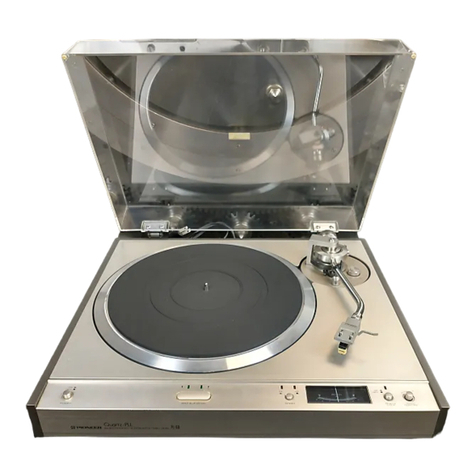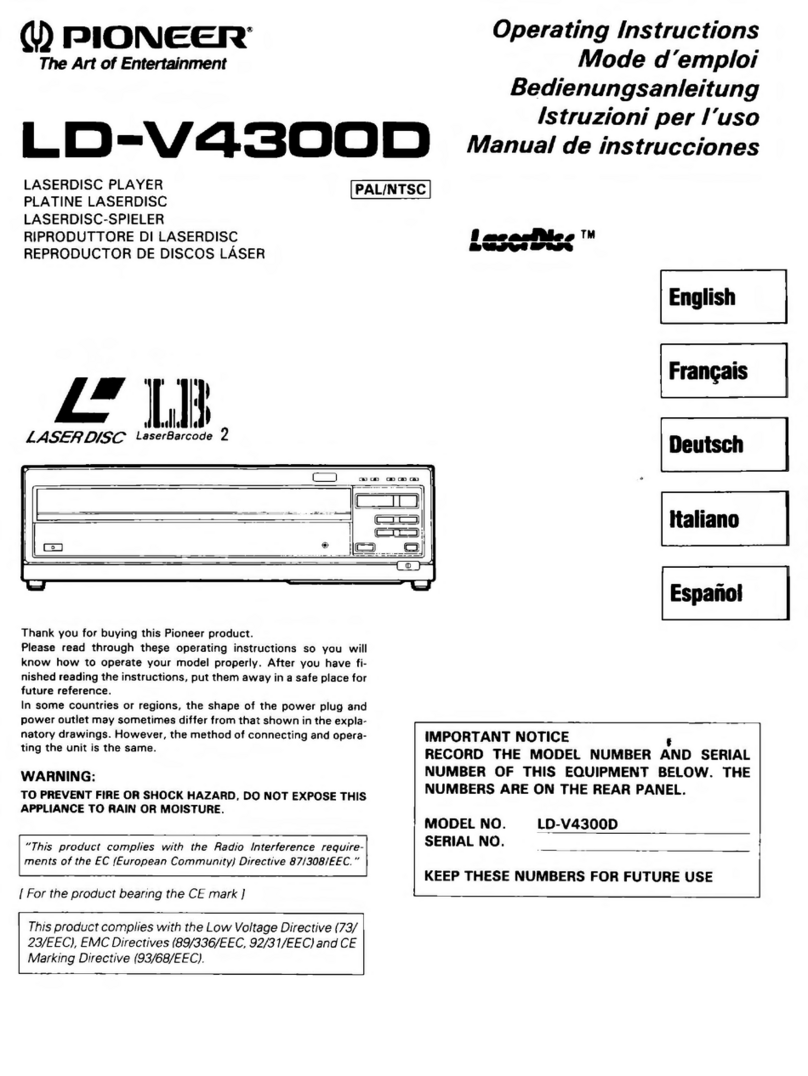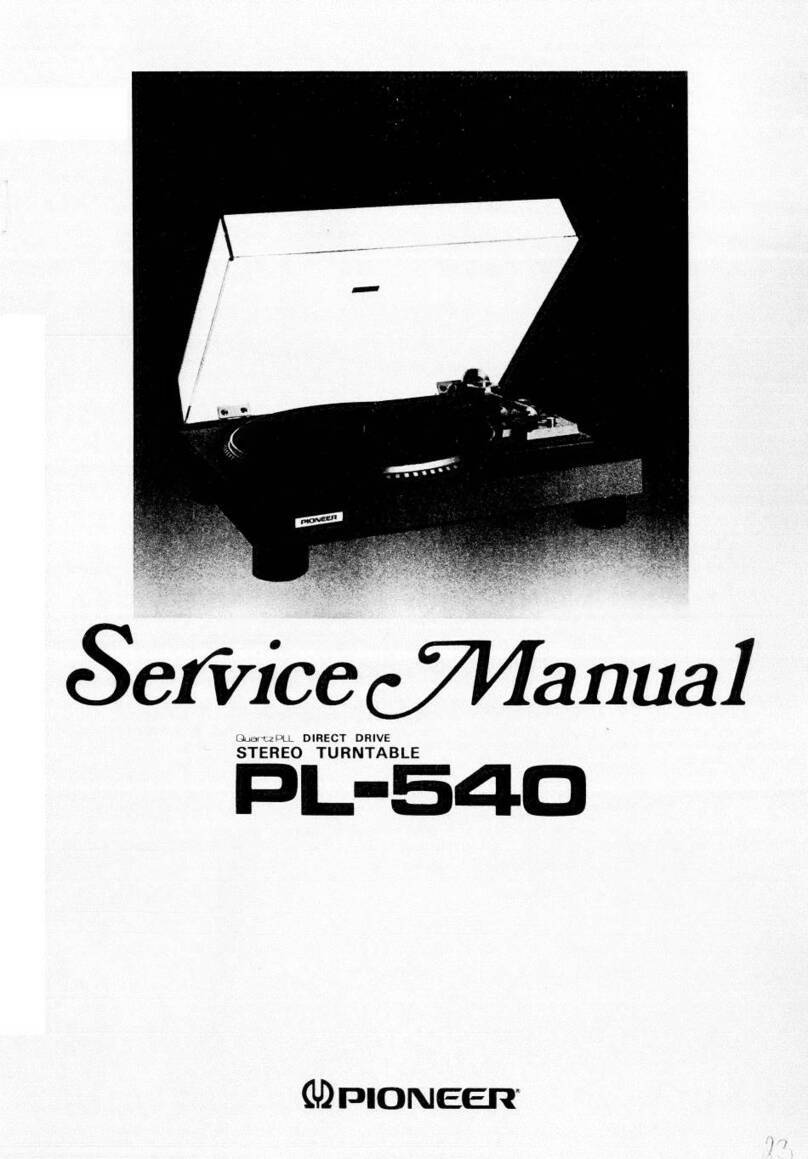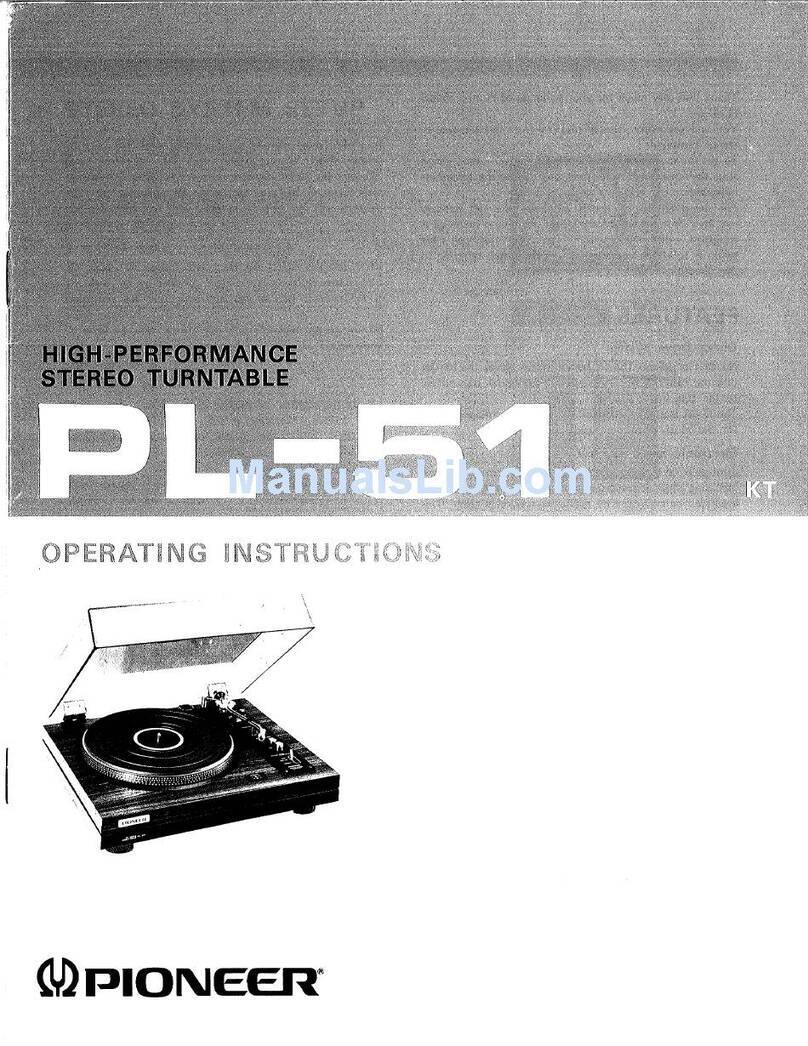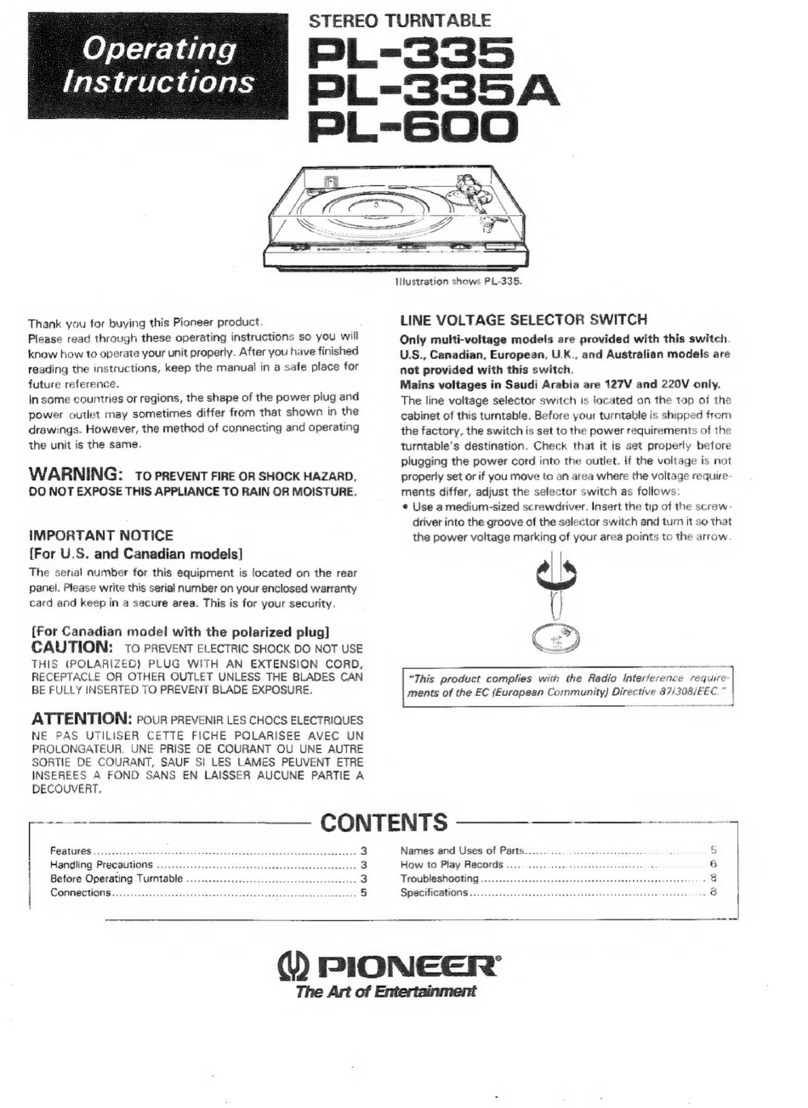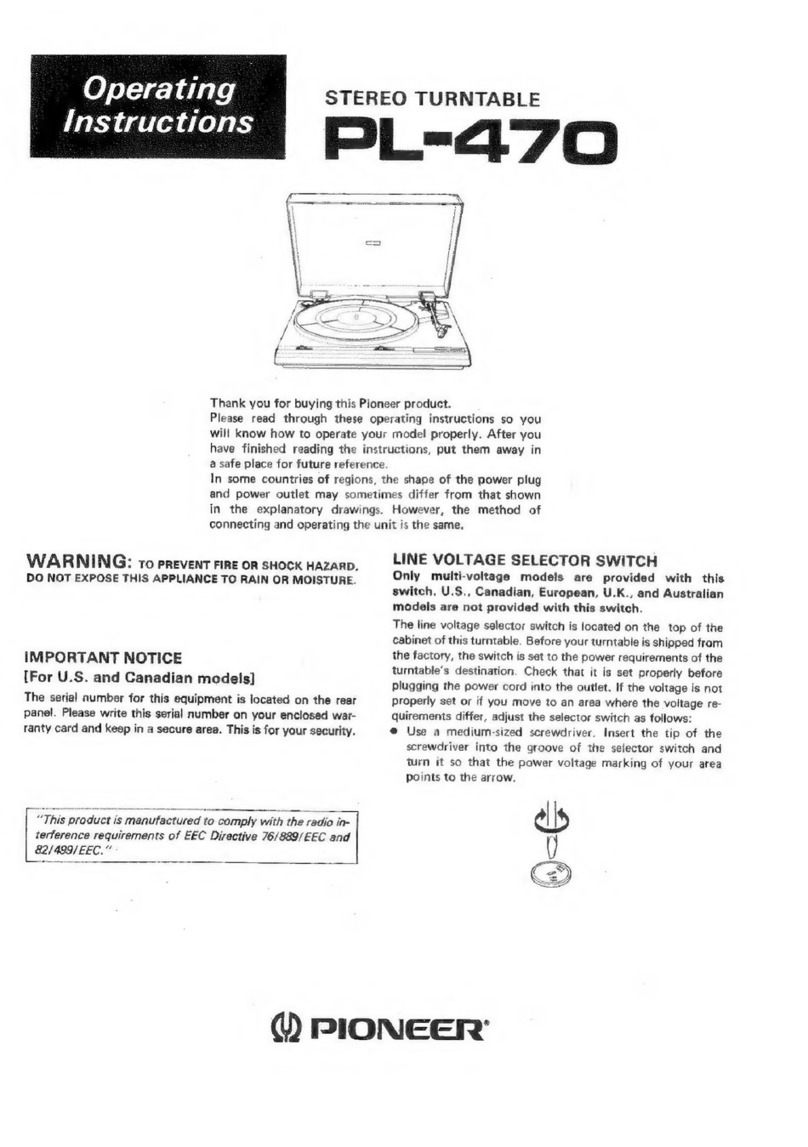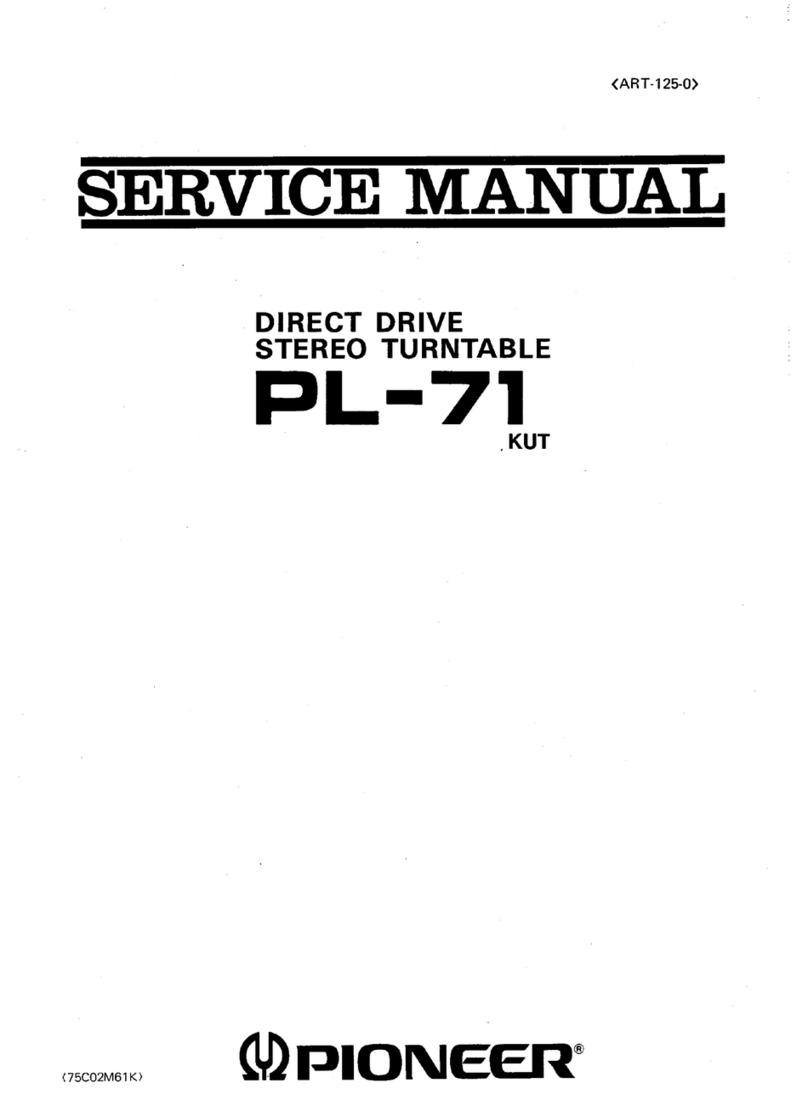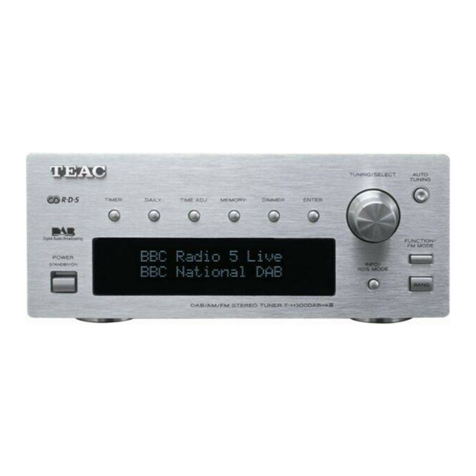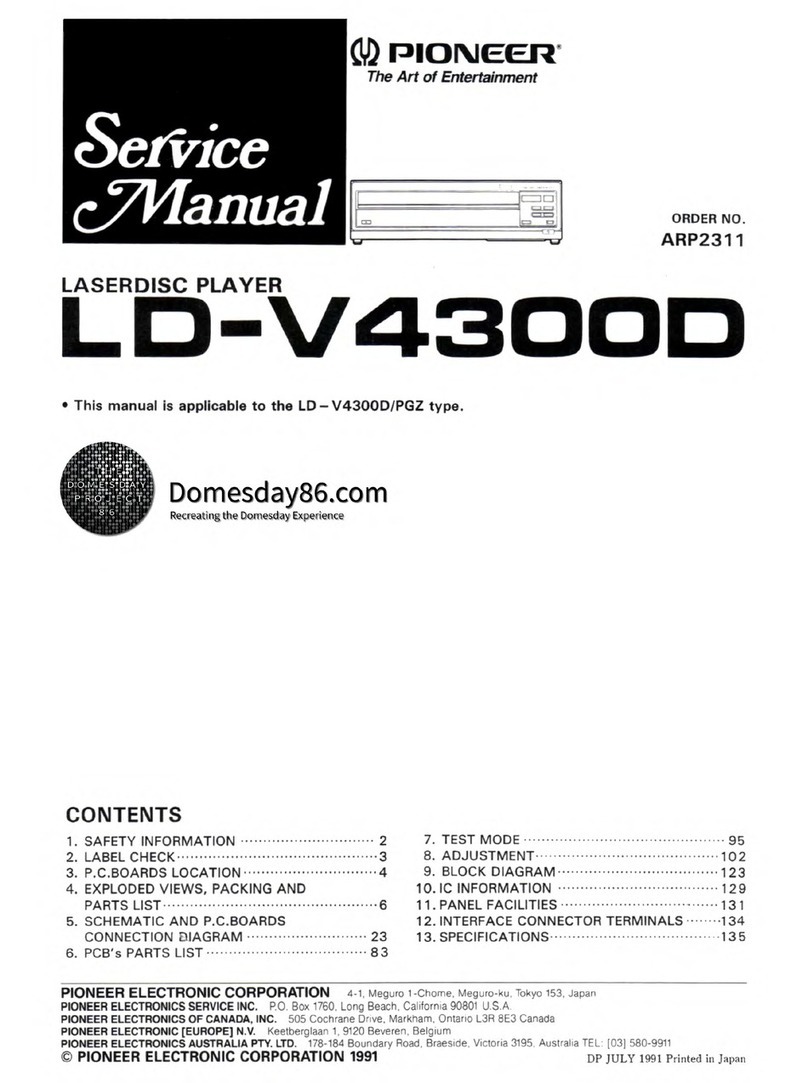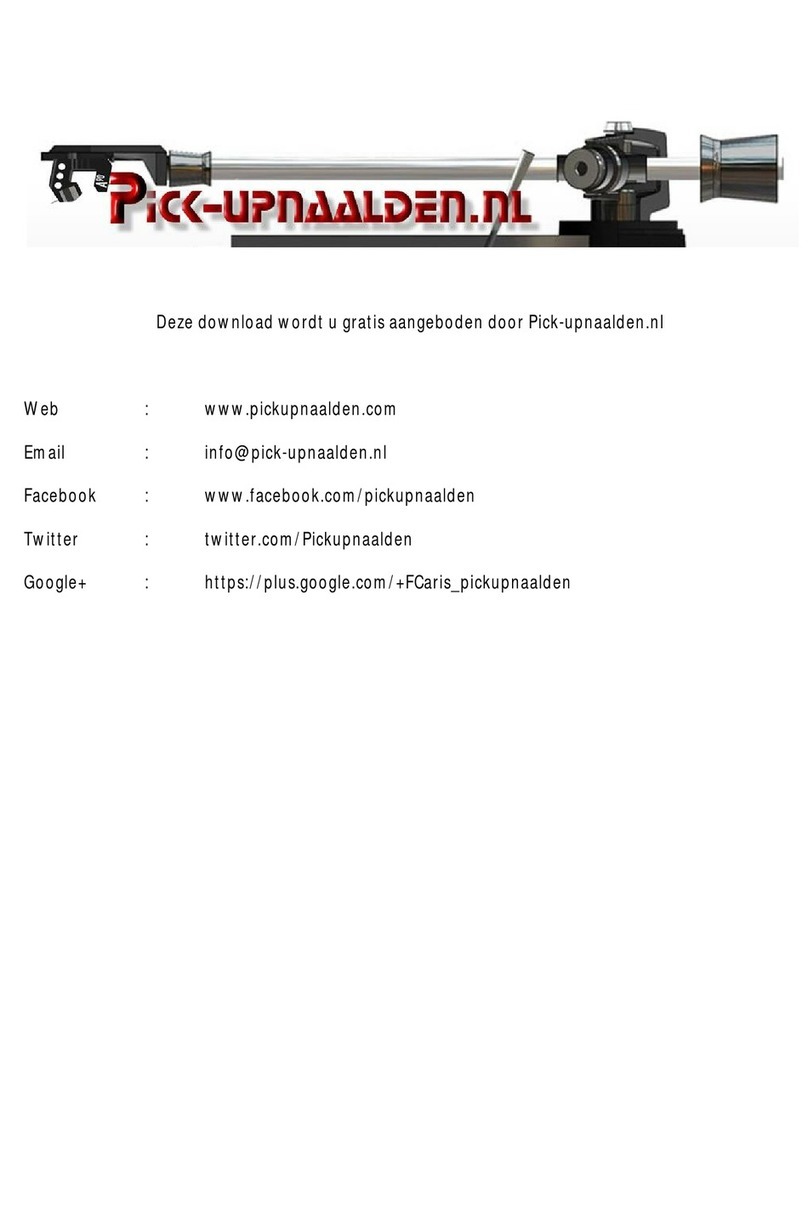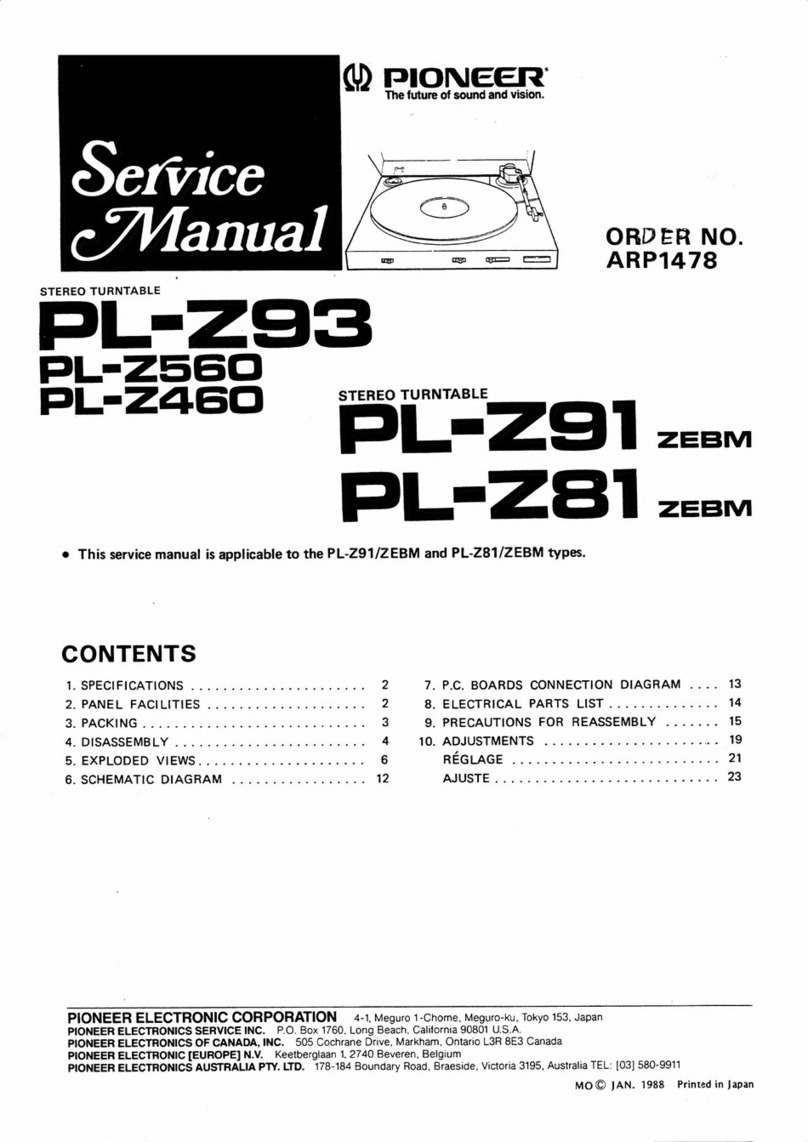
2.
SPECIFICATIONS
Motor
and
Turntable
Drive
SYSt@M
........ccecceeneeeeecesenaveseeaesaeeaeaneees
Direct-drive
Mtr:
dsisede
diets
cotta
side
baceeneswnes
oe
Csleeee
Quartz
PLL
Hall
motor
Turntable
Platter
.....
304
mm
diam.
aluminum
alloy
die-cast
Speeds:
-efecsscucatsist
hive
ting,
weed
wets
coeeaes
33-1/3
and
45
rpm
Wow
and
Flutter
................00e
Less
than
*0.012%
(WRMS)
0.025%
(WRMS)
+
0.035%
WTD
Peak
(DIN)
Values
marked
with
an
‘“*”
designate
the
wow
and
flutter
for
the
motor,
and
do
not
include
the
cartridge
or
tonearm
load.
Signal-to-Noise-Ratio
............5..08
More
than
80
dB
(DIN-B)
(with
Pioneer
cartridge
model
PC-301)
Motor
characteristics
Startup
.....
0...
eee
eee
Less
than
1/3
revolution
Speed
variation
..........00
eee
Less
than
0.002%
Dirifte
cacbsdicee
stand
anaes
eons
So
Time:
0.0003%/h
Temp:
0.003%/°C
Tonearm
TYD0issisccd
and
siviasetsdeve
wehea
otek
Integrated
straight
tonearm
TYPO
ccccsesccvateva
ves
tuvedavdetsavesdvescviavteuvenerssdesarersss
IM
type
Stylus:
s.ssvseceadideentvevesetenede
0.3
x
0.7
mil
diamond
(PN-301)
Output
Voltage.
.ves
sccscws
de
iacisiveavevenaveorecctieesst
eves
2.5
mV
(1
kHz,
5
cm/s
LAT.
Peak)
Tracking
Force
...........cceseeeeeees
1g
to
1.5
g
(proper
1.25
g)
Frequency
RESponse
..........csceeceescetseseeeenen
10
to
33,000
Hz
Recommended
Load
...........:.:eceeeeceeuceeeeeneeeeneeeacuees
50
ka
WEIGAE
iiccvoctaeefesntxnsttucemilecsve
cient
testuetateaessMeneaered
ye
4g
Subfunctions
Auto
lead-in,
auto
return,
auto
cut,
repeat,
arm
elevation,
program
search
play,
manual
play,
skip,
auto
disc
size
selector,
record
detection,
auto
speed
selector
INFORMATION
TO
USER
[FOR
U.S.A.
MODEL]
This
equipment
generates
and
uses
radio
frequency
energy
and
if
not
installed
and
used
properly,
that
is,
in
strict
accordance
with
the
manufacture’s
instructions,
may
cause
interference
to
radio
and
television
recep-
tion.
It
has
been
type
tested
and
found
to
comply
with
following
measures:
the
limits
for
a
Class
B
computing
device
in
accordance
*
reorient
the
receiving
antenna
if
this
equipment
does
cause
interference
to
radio
or
television
reception,
which
can
be
determined
by
turn-
ing
the
equipment
off
and
on,
the
user
is
encouraged
to
try
to
correct
the
interference
by
one
or
more
of
the
Miscellaneous
Power
Requirements
HEM,
HB,
HP
models
...............0.00008
AC
220
V/240
V~
(switchable),
50,
60
Hz
KU,
KC
models
...........cecececeeeseeeeeeeeeees
AC
120
V,
60
Hz
S,
S/G
models
............
AC
110V/120
V/220
V/240
V~
(switchable),
50,
60
Hz
Power
Consumption
HEM,
HB,
HP
models
.............cccsceeeeeeeeeeeereeeeeeers
15W
KU,
KC
models
aise
cdscccssctucciviverecscvbesecsevedocesseads
14W
S\S/GMOElS!
i
vis
sissosceencss
dbcexcncutensvedtesnecdec
tack’
10W
Dimensions
.............cceeeeeees
420
(W)
x
108
(H)
x
365
(D)
mm
16-1/2
(W)
x
4-1/4
(H)
x
14-3/8
(D)
in.
Weight
us
scasseccaseed
sacsdouvevecantuesebceveunss
surom
eevee
s
5kg/11
Ib
Accessories
EP
Adapter
......cccceccseesecseceeseeeneececeeseeeaeeneeeeeetnesereees
1
Operating
Instructions
............cccseeeseeeeeeeaeeeeeseeaneeneesenes
1
NOTE:
Specifications
and
design
subject
to
possible
modification
without
notice,
due
to
improvements.
lf
necessary,
the
user
should
consult
the
dealer
or
an
ex-
perienced
radio/television
technician
for
additional
sug-
gestions.
The
user
may
find
the
following
bookiet
prepared
by
the
Federal
Communications
Comission
helpful:
“How
to
Identify
and
Resolve
Radio-TV
Interference
with
the
specifications
in
Subpart
J
of
Part
15 of
FCC
¢
relocate
this
component
with
respect
to
the
Problems”.
Rules,
which
are
designed
to
provide
reasonable
protec-
receiver
tion
against
such
interference
in
a
residential
installa-
*®
move
this
component
away
from
the
receiver
tion.
However,
there
is
no
guarantee
that
interference
¢
plug
this
component
into
a
different
outlet
so
that
component
and
receiver
are
on
different
branch
cir-
will
not
occur
in
a
particular
installation.
cuits.
This
booklet
is
available
from
the
US
Government
Prin-
ting
Office,
Washington,
D.C.,
20402,
Stock
No.
004-000-00345-4.
The
above
instructions
apply
only
to
units
which
will
be
operated
in
the
United
States.
3.
FRONT
PANEL
FACITIES
Hip
o_o
3
6
@
POWER
switch
Press
this
switch
to
turn
the
power
on
and
off.
[ON]
(depressed
position)
:
Power
is
switched
ON.
[STAND-BY]
(released
position):
Power
is
switched
OFF.
@
PROGRAM
switches/indicator
e
Press
these
switches
in
the
desired
sequence
from
[1]
through
[8]
when
programming
the
order
in
which
the
tracks
are
to
be
played.
The
tracks
are
programmed
in
the
order
in
which
the
switches
were
pressed,
and
auto
play
or
repeat
play
is
performed.
e
The
numbers
[1]
through
[8]
indicate
the
order
of
the
tracks
on
the
record
(for
instance,
the
[2]
switch
cor-
responds
with
the
second
track).
During
programmed
playback,
the
program
indicator
corresponding
to
the
track
presently
being
played
will
flash.
@
CLEAR
switch
This
switch
is
pressed
in
order
to
clear
the
program.
@
REPEAT
switch/indicator
Press
this
switch
so
that
the
indicator
lights
for
repeat
play.
@©
LOCATE/SKIP
switches
(SKIP)
Use
these
switches
to
start
manual
playback,
or
during
playback
to
change
the
track
being
played.
When
the
switches
are
pressed,
the
tonearm
will
move
to
the
right
or
left.
[<4]:
Tonearm
moves
to
left.
During
programmed
play,
moves
to
the
next
programmed
track.
If
pressed
multiple
times,
moves
ahead
the
number
of
tracks
corresponding
to
the
number
of
times
the
switch
is
pressed.
[>
]:
Tonearm
moves
to
right.
During
programmed
play,
moves
back
to
the
beginning
of
the
track
presently
being
played.
If
pressed
multiple
times,
moves
back
the
number
of
tracks
corresponding
to
the
number
of
times
the
switch
is
pressed.
PL-L7O
NOTE:
When
this
switch
is
used
during
programmed
play,
do
not
allow
more
than
a
1-second
interval
between
presses.
©
ARM
ELEVATION
switch(UP)/
indicator
e
Use
the
switch
for
manual
play.
e
Use
the
switch
to
suspend
record
play
temporarily.
e
Use
the
switch
when
changing
the
tracks
during
manual
play.
{UP]
indicator
lights:
The
tonearm
rises
(the
stylus
moves
away
from
the
record).
[UP]
indicator
goes
out:
The
tonearm
descends
(the
stylus
is
lowered
onto
the
record).
@
START/STOP
switch
Depress
this
switch
when
starting
auto
play
or
when
stop-
ping
play.
SPEED
switch
Set
this
switch
in
accordance
with
the
speed
of
the
record
which
is
to
be
played.
[AUTO]:
Automatically
sets
rotation
speed
in
accordance
with
the
size
of
the
record:
Rotates
at
33-1/3
rpm
with
30
cm
and
25
cm
records.
Rotates
at
45
rpm
with
17
cm
records.
[33]:
Rotates
at
33-1/3
rpm
[45]:
Rotates
at
45
rpm
@
SENSOR
switch
Depending
on
the
type
of
record
being
played,
this
switch
may
be
used
to
adjust
the
sensitivity
at
the
time
of
program.
med
play.
Normally
the
switch
should
be
left
in
[N]
position.
[N]:
For
normal
records.
[H]:
For
records
with
very
narrow
intervals
between
tracks,
[L]:
For
records
with
wide
sound-groove
pitch.
d)
Platter
qd)
Rubber
mat
@)
Platter
shaft
a)
Tonearm
Cartridge
(PC-301)
(@
EP
adapter
This
is
used
when
playing
records
with
a
“large
center
hole”.
Cabinet
@
Dust
cover
